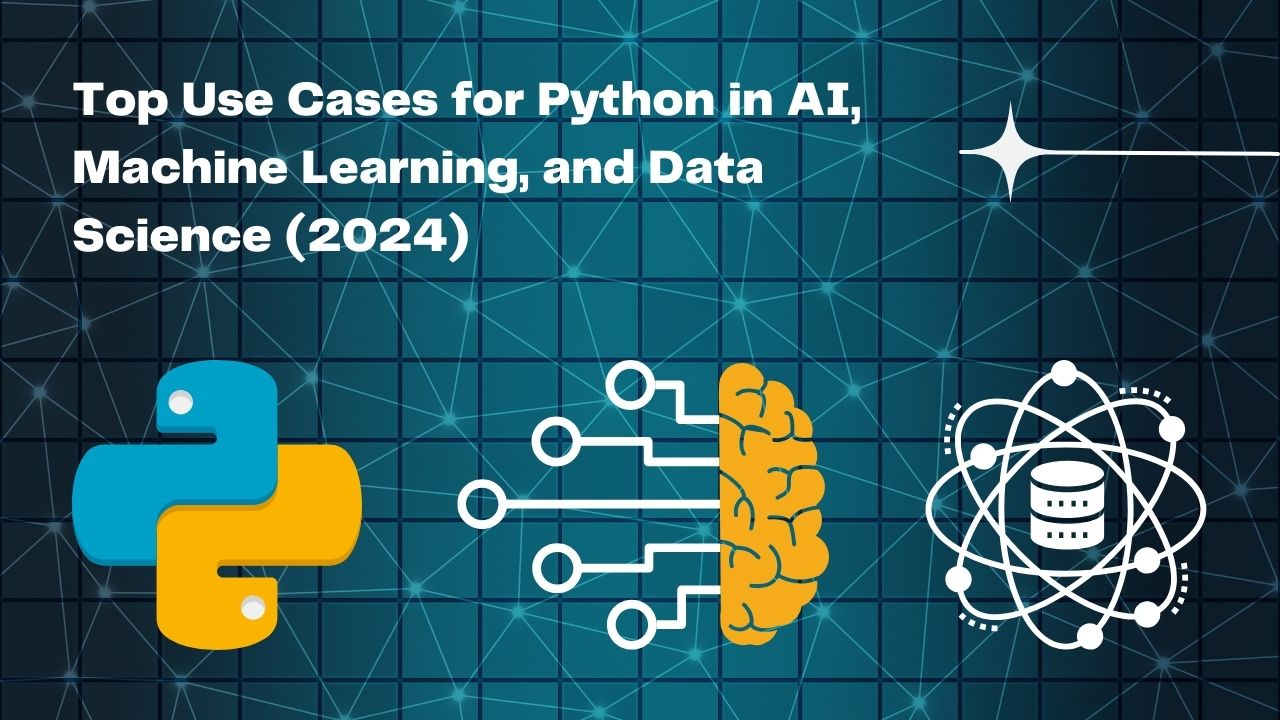Top Use Cases for Python in AI, Machine Learning, and Data Science (2024)
- 1 Streamlined Data Analysis and Visualization
- 2 Machine Learning Algorithm Development and Evaluation
- 3 Natural Language Processing (NLP) Applications
- 4 Computer Vision and Image Recognition
- 5 Building Scalable Web Applications and APIs
- 6 The Python Advantage: Why Hire Python Developers for Your AI/ML Project?
- 7 Conclusion: Python – The Indispensable Language for AI and Data Science
- 7.1 Frequently Asked Questions (FAQ)
- 7.1.1 1. Is Python the only language suitable for AI and data science?
- 7.1.2 2. What are some challenges of using Python for AI and data science?
- 7.1.3 3. What skills should a Python developer possess for AI and data science projects?
- 7.2 4. Where can I learn Python for AI and data science?
Python’s popularity in artificial intelligence (AI), machine learning (ML), and data science continues to soar in 2024. This versatile and beginner-friendly language offers a powerful combination of readability, extensive libraries, and a supportive community. Let’s explore why Python reigns supreme in these rapidly evolving fields.
Streamlined Data Analysis and Visualization
Data analysis forms the foundation of any AI or ML project. Python excels in this area, along with libraries like Pandas and NumPy. Pandas provides high-performance, easy-to-use data structures like DataFrames for efficient data manipulation and analysis. NumPy offers powerful tools for numerical computing, linear algebra operations, and array manipulation crucial for data preparation and analysis.
These libraries work seamlessly together, allowing you to:
- Load and clean diverse data formats (CSV, JSON, Excel)
- Perform exploratory data analysis (EDA) to understand data characteristics
- Handle missing values and outliers effectively
- Create informative visualizations (histograms, scatter plots, boxplots) using Matplotlib or Seaborn
Python empowers data scientists to focus on extracting valuable insights from data by simplifying data wrangling and visualisation tasks.
Machine Learning Algorithm Development and Evaluation
Python boasts a rich ecosystem of machine-learning libraries, making it ideal for algorithm development and implementation. Here are some of the most popular libraries:
- Scikit-learn provides a comprehensive set of tools for various machine learning tasks, including classification, regression, clustering, and dimensionality reduction. Its user-friendly interface makes it an excellent choice for both beginners and experienced data scientists.
- TensorFlow and PyTorch: These deep learning frameworks allow you to build and train complex neural networks for tasks like image recognition, natural language processing (NLP), and recommender systems. Their flexible architectures accommodate diverse deep-learning applications.
- XGBoost: A powerful library for building highly accurate gradient boosting models, particularly effective for structured data and achieving high predictive performance.
These libraries offer pre-built algorithms and the flexibility to customize them for specific needs. Python’s clear syntax makes it easy to understand and debug code, facilitating the iterative process of building and refining machine learning models.
Natural Language Processing (NLP) Applications
The ability to understand and process human language is crucial for AI systems. Python provides powerful NLP libraries like spaCy and NLTK that empower you to:
- Perform text pre-processing tasks like tokenization, stemming, and lemmatization
- Extract named entities (people, locations, organizations) from text data
- Build sentiment analysis models to gauge the emotional tone of the text
- Develop chatbots and virtual assistants capable of engaging in natural language conversations
These capabilities unlock various NLP applications, including sentiment analysis of social media data, topic modelling for understanding document themes, and machine translation for language communication.
Computer Vision and Image Recognition
Python excels in computer vision tasks with libraries like OpenCV and Pillow. These libraries empower you to:
- Load, manipulate, and display images
- Apply image processing techniques (resizing, filtering, edge detection)
- Build image recognition models to classify objects within images
- Develop computer vision applications like facial recognition and object detection
Python’s integration with these libraries makes it ideal for tasks like automated image analysis in medical imaging, self-driving car development, and security systems with facial recognition capabilities.
Also Read: The Future Of Python: What’s Next For This Popular Programming Language
Building Scalable Web Applications and APIs
Many AI and ML models are deployed as web applications or APIs for real-world use. Python’s robust web development frameworks like Django and Flask streamline this process. These frameworks provide tools for:
- Building user interfaces (UIs) to interact with AI models
- Creating APIs that expose model predictions to external applications
- Integrating databases for data storage and retrieval
- Deploying web applications on production servers
By leveraging these frameworks, data scientists and developers can seamlessly integrate AI and ML models into web applications and APIs, making them accessible to a broader audience.
The Python Advantage: Why Hire Python Developers for Your AI/ML Project?
Several factors solidify Python’s position as the preferred language for AI, ML, and data science projects:
- Readability and Ease of Learning: Python’s clear syntax and simple code structure make learning easier than many other languages. This allows data scientists and developers to focus on problem-solving rather than battling complex syntax.
- Extensive Libraries and Frameworks: The vast ecosystem of Python libraries provides ready-made solutions for most AI, ML, and data science tasks, significantly reducing development time and effort.
- Active Community and Support: Python boasts a large and active community of developers and data scientists. This translates to readily available online resources, tutorials, and forums for troubleshooting and knowledge sharing.
- Scalability and Integration: Python code is known for its readability and maintainability, making it easier to scale complex AI projects as they evolve. Additionally, Python integrates seamlessly with other programming languages, allowing for incorporating specific functionalities where needed.
- Open-Source and Cost-Effective: Python is an open-source language, eliminating licensing costs often associated with proprietary software. This makes it an attractive option for businesses and organizations of all sizes.
Considering these advantages, hiring Python developers is a strategic decision for any organization venturing into AI, ML, or data science. A Python Development Company with a team of experienced developers can provide the expertise necessary to build robust, scalable, and effective AI-powered solutions.
Conclusion: Python – The Indispensable Language for AI and Data Science
Python’s dominance in AI, ML, and data science is well-deserved. Its readability, powerful libraries, active community support, and cost-effectiveness make it the language of choice for many applications. Python will remain at the forefront as these fields evolve, empowering developers and data scientists to create groundbreaking solutions that shape the future.
Ready to leverage the power of Python for your AI/ML project? Consider partnering with a reputable Python Development Company. Their expertise in Python development and AI/ML applications can help you bring your innovative ideas to life.
Frequently Asked Questions (FAQ)
1. Is Python the only language suitable for AI and data science?
While Python is dominant, other languages like R, Java, and C++ are also used in AI and data science. R excels in statistical analysis and data visualization, Java for large-scale distributed computing, and C++ for computationally intensive tasks where speed is critical. However, Python’s overall ease of use and extensive libraries often make it the preferred choice.
2. What are some challenges of using Python for AI and data science?
- Speed: For computationally intensive tasks, Python can be slower than compiled languages like C++. However, libraries like NumPy with optimized code mitigate this to some extent.
- Memory Management: Python’s automatic memory management can sometimes be less efficient than manual management. Careful memory usage practices are crucial for large datasets.
- Not Ideal for Very Large-Scale Projects: Other languages like Java might be better suited for exceptionally large-scale projects requiring distributed computing.
3. What skills should a Python developer possess for AI and data science projects?
In addition to strong Python programming skills, desirable skills include:
- Machine Learning and Deep Learning Fundamentals: Understanding core concepts like algorithms, model evaluation, and deep learning architectures.
- Data Analysis and Visualization: I am familiar with libraries like Pandas, NumPy, Matplotlib, and Seaborn for data manipulation and visualization.
- Problem-Solving and Analytical Thinking: The ability to approach problems creatively and extract meaningful insights from data.
- Communication and Collaboration: Effectively communicating technical concepts to non-technical stakeholders and collaborating with data scientists and engineers.
4. Where can I learn Python for AI and data science?
Numerous online resources are available, including:
- Online Courses: Platforms like Coursera, edX, and Udacity offer comprehensive courses on Python for data science and machine learning.
- Tutorials and Documentation: Official documentation for libraries like pandas, sci-kit-learn, and TensorFlow provides valuable learning resources.
- Books: Many excellent books cover Python for data science and machine learning, catering to different learning styles.
5. How can I find a reputable Python Development Company for my AI/ML project?
Look for companies with:
- Experience in AI and ML Projects: A proven track record of successful AI/ML projects using Python.
- Team of Qualified Developers: A team with expertise in Python development and specific AI/ML areas relevant to your project.
- Strong Communication and Collaboration: The ability to clearly understand your project requirements and collaborate effectively.
- Cost-Effective Solutions: Competitive pricing and transparent project costing.
Considering these factors, you can find a Python Development Company that empowers you to bring your AI/ML project to fruition.

















